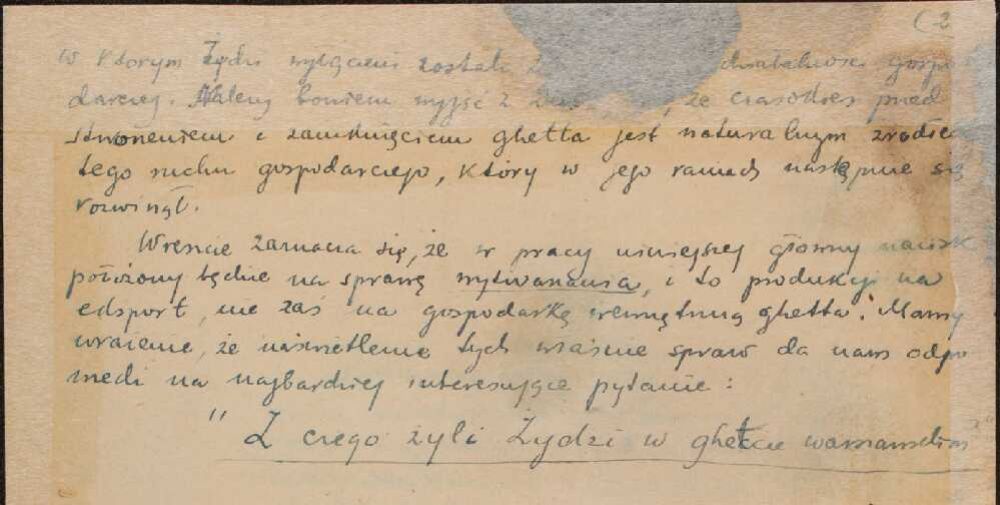- News
- Events
- Oneg Shabbat
- Collections
- Research
- Exhibitions
- Education
- Publishing Department
- Genealogy
- About the Institute
- Bookstore


Jerzy Winkler completed studies in economics in Vienna before the war and worked at the economics department of the YIVO. During the war, he was employed at the Commission For Constructive Work of the Social Work Department, and at the Warsaw Ghetto, thanks to his friendship with Józef Jaszuński, a member of the Judenrat, he had found employment at the Statistics Department of the Jewish Council. This position gave him access to important documents of the Council and its mail exchange with the German authorities. He was copying some of these documents and passing them to Oneg Shabbat. The Ringelblum Archive contains several documents like this, copied by hand by Winkler. Unclear writing indicates that he was probably doing it in a rush, during times when he was not under anyone’s observation. [1]
Winkler was also the author of a few works, mostly dedicated to statistics, written especially for the Archive. The subjects of the include an analytical report on prisoners sent to labour camps and a text written in Yiddish about the health condition of Jews imprisoned in the Warsaw Ghetto. Winkler was also planning to write a section on economy in the „Two and a half years of war” summary, together with Menachem Linder.
The most important work by Winkler remains The Ghetto fights against economic oppression, a study written in Polish. He described the intricacies of German politics of exploitation of Jewish economic potential. [2] The Jewish presence in a wider circuit of economy was a part of the German war economy plan. German and Polish merchants active in various fields of production – textiles, brushmaking, carpentry or shoemaking – were making orders through Jewish middlemen, who were using Jewish workforce – the people from the ghetto. Despite very low pay offered to the latter, earned money helped sustain thousands of families. Winkler was also analysing how Jews were coping with finding resources necessary for productions, opening new workshops and exporting goods to the „aryan side”. [3] The report was written by Winkler in past tense – he was addressing it to researchers reading it after the war. [4]
![winkler_2_ARG-I-629_4.jpg [147.09 KB]](https://www.jhi.pl/storage/image/core_files/2022/3/23/74c403acc5329a070362846db6536257/jpg/jhi/preview/winkler_2_ARG-I-629_4.jpg)
This work doesn’t have an ambition to be a strictly scientific one, neither does it provide a complete economic history of the Warsaw Ghetto. It is rather a collection of observations and facts, which the author tried to gather possibly truly to the sources and analyse systematically.
These observations and analyses are intended to present how economic forces active in the ghetto burst beyond its narrow walls, how a producer struggles for the market, materials, tools. They are a testimony of the fact that the struggle continued not only against external conditions, enforced by the occupant, but also within the ghetto itself: with the Jewish competitor, Jewish businessman, Jewish exploiter. They were also provide an image of how the Polish economy, even under the German boot, cannot survive without the Jewish economic factor, as well as a proof that even nationalist „Kriegswirtschaft” (war economy) has to rely on Jewish workforce and Jewish trading skills.
Its is also emphasised here that the main focus will be places on production – mainly for export, not for the internal economy of the ghetto. We believe that shedding light on these issues will provide an answer to the most interesting question:
„How did the Jews make a living in the Warsaw Ghetto?”
![winkler_3_ARG-I-615_8.jpg [76.79 KB]](https://www.jhi.pl/storage/image/core_files/2022/3/23/9186e865b0a8a87a6a4b08f9ac4ab28f/jpg/jhi/preview/winkler_3_ARG-I-615_8.jpg)
At night, between 2 and 3 December 1941, an inventory of all working animals was conducted by the Office of Statistics in Kraków on the entire area of the General Gouvernement. In the Warsaw Ghetto, the inventory was conducted by the Department of Statistics of the Jewish Council. It included: 183 horses, 248 milk cows, 1 hen and… 4 beehives (property of Toporol). Apart from that, there were about 10 rabbits. Altogether, the animals belonged to 304 owners.
(translated by Olga Drenda)
![winkler_4_ARG-II-326_7.jpg [124.21 KB]](https://www.jhi.pl/storage/image/core_files/2022/3/23/cc7b1fc0950747b433d796d9f28c0f4e/jpg/jhi/preview/winkler_4_ARG-II-326_7.jpg)
Indexes of German companies which were exploiting forced labour of Jewish workers
After 21.11.[1942] / The Ringelblum Archive
The Great Deportation, began by the Germans on 22 July 1942, caused an emotional breakdown in him. As a disabled person, with an ill hand, he was aware that he had small chances of surviving the selection. At the very beginning, he was sent to the Umschlagplatz, but his friends from the Judenrat managed to save him. [5] Next time, the fate wasn’t as kind to him. He was murdered together with his wife in Treblinka, probably in August 1942. He was in his thirties.
![winkler_5_ARG-I-573_8.jpg [86.96 KB]](https://www.jhi.pl/storage/image/core_files/2022/3/23/e64bc19d34dfa4db2436cabf7e04234d/jpg/jhi/preview/winkler_5_ARG-I-573_8.jpg)
Analyses and tables regarding mortality in the Warsaw Ghetto based on surveys
The Ringelblum Archive
Written by: Anna Majchrowska
Translated by: Olga Drenda
Footnotes:
[1] Introduction [in:] The Ringelblum Archive, Rada Żydowska w Warszawie (1939-1943), ed. Marta Janczewska, vol. 12, UW, Warsaw 2014, p. XXXII.
[2] Samuel D. Kassow, Who will write our history?, JHI, Warsaw 2017, p. 471.
[3] Ibidem.
[4] Introduction [in:] The Ringelblum Archive, Getto warszawskie. Życie codzienne, ed. Katarzyna Person, vol. 5, JHI, Warsaw 2011, p. XXIII.
[5] Samuel D. Kassow, Who will write our history?, op. cit., p. 311-312.
Bibliography:
The Ringelblum Archive, Getto warszawskie. Życie codzienne, ed. Katarzyna Person, vol. 5, JHI, Warsaw 2011.
The Ringelblum Archive, Rada Żydowska w Warszawie (1939-1943), ed. Marta Janczewska, vol. 12, UW, Warsaw 2014.
Samuel D. Kassow, Who will write our history?, JHI, Warsaw 2017.